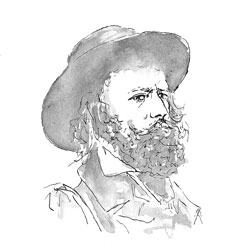Reading ‘Tears, idle tears’ (6): Have Your Say
Tears, idle tears, I know not what they mean,
Tears from the depth of some divine despair
Rise in the heart, and gather to the eyes,
In looking on the happy Autumn-fields,
And thinking of the days that are no more.Fresh as the first beam glittering on a sail,
That brings our friends up from the underworld,
Sad as the last which reddens over one
That sinks with all we love below the verge;
So sad, so fresh, the days that are no more.Ah, sad and strange as in dark summer dawns
The earliest pipe of half-awaken'd birds
To dying ears, when unto dying eyes
The casement slowly grows a glimmering square;
So sad, so strange, the days that are no more.Dear as remember'd kisses after death,
And sweet as those by hopeless fancy feign'd
On lips that are for others; deep as love,
Deep as first love, and wild with all regret;
O Death in Life, the days that are no more.
F.R. LEAVIS thought that 'complexity' was 'not a marked characteristic of Tennyson's poem' and that 'it moves simply forward with a sweetly plangent flow'.
CLEANTH BROOKS thought that Tennyson's poem was not 'a gentle melancholy reverie' because its 'images... rise up with a strange clarity and sharpness that shock' the complex character, 'Tennyson's Weeper'.
HEATHER GLEN thinks that it is useful to historicize Tennyson's poem. Highlighting certain facts about Tennyson and the original status of 'Tears, idle tears' as an embedded lyric within a longer poem, The Princess, Professor Glen also questioned whether Tennyson purposefully uses 'images of that over which human beings have no control' to create a sense of human frailty in the poem, and questioned whether its 'failure to do what Leavis asks it to do is part of its point'.
HERBERT F. TUCKER thinks that Tennyson's poem 'provides a symbolic meditation on the paradoxical presence of absence within the memory' and that its subject is 'thinking about thinking'. Through theorising about Tennyson's uses of language and imagery in the embedded lyric, Tucker also claims that 'Tears, idle tears' actively 'discourage[s] interest in the speaking subject'.
If you want to make a comment, or to say something about this poem that none of these critics has said, please do. These critics have by no means exhausted this poem, and it's a certainty that new emphases and new interpretations will rise and fall in the future. Remember also that the critical awareness and apparatus being explored here might be relevant when you are interpreting Tennyson's other poetry (and, indeed, any other poetry).

April 10th, 2011 at 4:47 pm
To say the focus of the poem is thinking about thinking is making more of that trenchant point than it should have to bear. The character and power of memory is often rejected by those who see life as progress, as Princess Ida rejects the song. The abiding freshness of “Death in Life” is startling to the mainstream of our culture, which since Tennyson’s time, and thus the tears seem “idle” — but not I would wager to the speaker at the end of the poem.
June 21st, 2011 at 9:08 pm
“I know not what they mean” doesn’t seem ultimately to say that the speaker doesn’t know why he’s cryiing. He understands that. So perhaps he means “Why now?”, in which case his question is why he has such sudden and unexpectedly intense feeling over something which happened long in the past.
Because Tennyson uses an image so similar to “In Memoriam”12, presumably referring to the ship returning Hallam’s body to England, I assume the poem is in the spirit of “In Memoriam”. In that case the last verse would perhaps be a way of saying that his feelings are inspired by the thought that Hallam is thinking of him even in death, and of pain that it was impossible for their relationship to develop. I don’t think he is necessarily consciously regretting the lack of a physical relationship, as similar concepts appear in IM without seeming to have that meaning.
If the poem is in fact personal (and it seems too powerful not to be) then the allusion to Keats (birdsong openining casements) tells us how important it is to Tennyson (no poet could casually recreate Keats). The absence of rhyme is a metaphor for direct speech, i.e. without poetic convention.
August 7th, 2012 at 6:33 am
When I first read the poem ‘Tears, idle tears’ to have a discussion in an undergraduate class, I find the poem is based on philosophy of human life. Why we lose the things we are attached to? Why do people die? Why do we need to confront some ‘divine despair’ in life? I thought and thought over it and found out that when we are born, we are happy. We know no despair. We feel ecstatic joy at every object we see, hear, taste, feel and smell. In this process we come in contact with various sights, sounds, activities etc. We feel attached to some of them spontaneously. Then we begin to yearn for them again and again. We are always scared of losing them. Thus we forget that we are mortal and believe in enjoying with these material things. However, matter is subject to decay and so we lose something we loved or became very close to us. Then it makes us think, is it fair? The result of such incidents or activities remain in the store house of our mind and sometimes it automatically begins to shed tears for something we lost long before. We begin to realise we too will lose our life. This haunts us more. We become philosophers, and where does time take us away like those sailing boats?